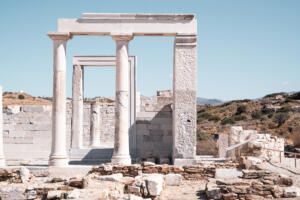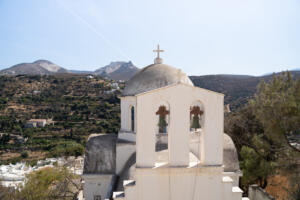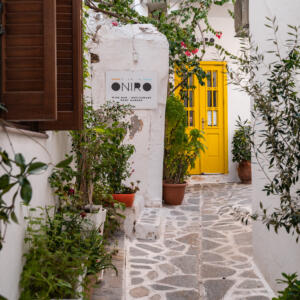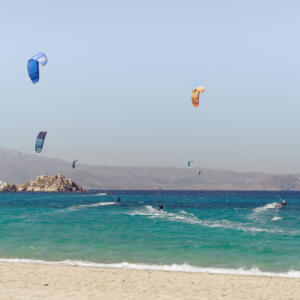A Greek Retreat
Choosing the perfect Greek island destination can feel daunting; there are over 20 inhabited islands in the Cyclades alone. While visitors flock to Santorini and Mykonos, neighboring Naxos is often overlooked. It offers the best of both worlds—gleaming towns and beaches balanced by mountains and rural authenticity. Whether seeking leisure or adventure, there’s something for every type of traveler.
History & Culture
 In 500 BC, Naxos was the most prosperous of the Greek islands. The quarrying of marble bolstered the economy and encouraged classical sculpture; this marble was used on the roof of the Acropolis. In later years, Naxos was ruled by the Byzantine empire followed by the Venetians and Ottomans. This foreign presence is apparent throughout the island. The main port of Chora is like a living museum; a labyrinth winds around the remains of the 13th-century Venetian castle. No cars can enter the oldest section, allowing visitors to quietly explore its alleys.
In 500 BC, Naxos was the most prosperous of the Greek islands. The quarrying of marble bolstered the economy and encouraged classical sculpture; this marble was used on the roof of the Acropolis. In later years, Naxos was ruled by the Byzantine empire followed by the Venetians and Ottomans. This foreign presence is apparent throughout the island. The main port of Chora is like a living museum; a labyrinth winds around the remains of the 13th-century Venetian castle. No cars can enter the oldest section, allowing visitors to quietly explore its alleys.
Framing the port is the iconic Portara, the only remains of an unfinished temple to Apollo. The marble gate dates to the fifth century BC and stands over 25 feet tall. If you’re familiar with Greek mythology, this is where Theseus left Ariadne after slaying the Minotaur. Each evening people blanket the hill for an unbeatable panoramic view of the sunset with Chora twinkling below. Unlike many historical monuments, Portara has no barriers for entry. It’s free and open to the public 24/7.
If renting a car, a short drive from Chora will bring you to the Temple of Demeter, built in 530 BC. You can view the well-preserved site and its accompanying museum for a few euros. And pushing further into the heart of the island will introduce you to many villages, each with its own unique history and landmarks. Highlights include the neoclassical Halki and all-marble Apiranthos. Keep an eye out for the striking white quarries while you traverse the island.
Hiking & Biking
Standing at roughly 3,300 feet, Mount Zas is near impossible to miss. It claims two titles: the highest mountain in the Cyclades and the childhood home of Zeus. There are two hiking routes that will bring you to the peak, although one will bypass Zeus’s cave. The longer one starting from Aria Spring is about three miles long with 1,600 feet of elevation change. Although the specs sound easy, be prepared for a bit of a scramble with your hands as the path ends. Still, the journey is idyllic with herbs and wildflowers growing along the trail edges. Farm goats freely roam the mountainside with their bells echoing across the valley.
Hikers of all levels might also find value in a guide on Naxos. Stella of Naxos Hiking was born and raised on the island, and reviewers rave about the personal stories and local knowledge she shares. She offers eight itineraries to choose from that vary in difficulty and landmarks, often concluding with a meal together at a taverna. If you’d rather fly solo, Naxos’s trails are easily numbered, although sometimes lacking clear signposts. Whatever you choose, memorable sights are guaranteed—from olive tree fields to Byzantine churches.
The variety of terrain and views makes for equally great biking opportunities. Routes cross the island, giving you the choice of mountain climbing, ocean siding, or riding along dirt roads through farmland. Several companies offer organized cycling tours and provide most of the equipment.
 Food & Drink
Food & Drink
Naxos’s fertile soil is a rarity in the Cyclades. Rather than relying on tourism, the island is proud to have a strong agricultural industry. Naxian potatoes are found on nearly every menu, alongside local cheese, honey and olive oil. Here are some culinary highlights:
- Galaktoboureko
Visit Kafeneio Galanis in Halki and grab a table beneath their impressive canopy of vines. The cafe is well known for their incredible galaktoboureko, a traditional Greek pastry made of custard and phyllo topped with syrup.
- Kitron
Before leaving Halki, stop into Vallindras Distillery. Naxos is the only island that produces a liqueur called kitron; the Vallindras family has been distilling it since 1896. Made from the citron tree, which is similar to that of the lemon, it has a familiar citrus note. Here you can sample the three liqueur types (clear, green and yellow).
- Moussaka
Moussaka is easily found, but Taverna Platanos in Apeiranthos is a step above the rest. Eggplant, potatoes, ground meat and béchamel are layered, baked and served steaming hot in traditional ceramic ware.
4. Local Cheese
Back in Chora, multigenerational Naxos Cheese Koufopoulos offers tastings in the lower part of the store. For only 15 euros, you can enjoy a glass of wine and 10 types of cheese with fruit, jam and crackers. The cheesemaker’s daughter provides an overview of the shop’s history and guides you through the pairings. Standouts include an unusual sour cheese known as xynotyro and salty arseniko cheese.
- Bulk Spices
Whether cooking on vacation or searching for products to send home, fragrant Tziblakis in Chora is a treasure trove. Another family-run business, this shop is nearly 100 years old. It’s hard to miss from the street—huge bins of spices and olives beckon through the doorway. Local items such as honey, ouzo and clay cookware fill every corner. Snap a photo to include with any gifted souvenirs.
Sand & Surf
Islands in the Aegean Sea are subject to strong, seasonal winds called the meltemi. These winds are channeled through the islands, with speeds typically highest July through September. If you’re searching for a relaxing spot in the sand, don’t fear: the size of Naxos means there are always beaches that remain sheltered and calm. One of the most popular, Agios Prokopios, features a long, golden beach well suited for families and close to Chora.
If you’re interested in water sports, Mikri Vigla beach in the south is world renowned. Here the meltemi works to enthusiasts’ favor, propelling wind- and kite-surfers around waves and dozens of feet in the air. Several companies offer lessons and rentals for beginner to advanced visitors. Winds remain strong year-round, making Naxos an excellent off-season playground.
Snorkel, kayak and sailing tours abound as well. Plan a visit to Rina Cave or a sunset dinner aboard. A handful of beach clubs offer lounge areas alongside rentals such as jet skis and flyboards. Greek business hours aren’t always strict, though, so it’s recommended to call ahead for any bookings.
How to Visit
The Greek ferry system is robust, and Naxos is serviced by multiple ferry lines. You can choose between large or high-speed boats, but they do make multiple stops and are often delayed by strong winds. Luckily, the island is one of a few with its own airport. Hop on a short flight from Athens for a quick start to an unforgettable vacation.


